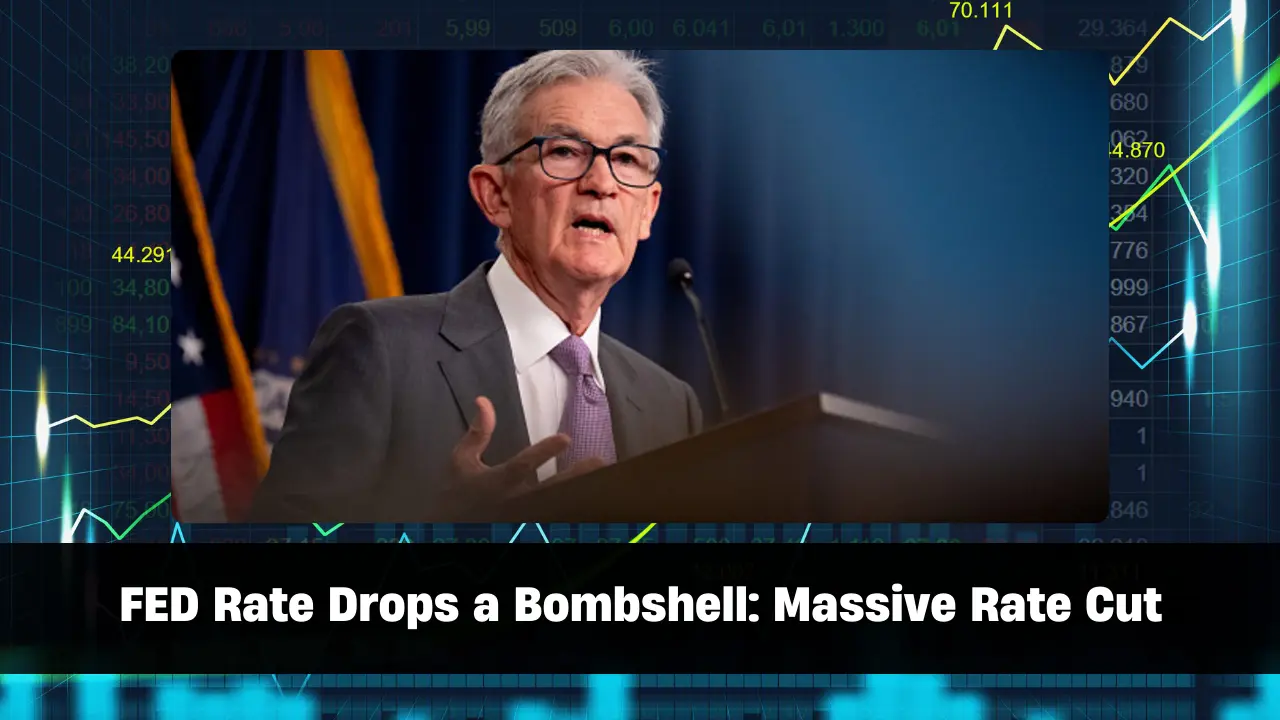Massive 50 Basis Points Rate Cut Here’s What’s Next » Sharedhan

FED Rate Drops: The U.S. Federal Reserve (FED) has finally delivered the long-anticipated decision to cut interest rates. The financial world had been waiting for this crucial moment, and it has now arrived. On Wednesday night, FED Chairman Jerome Powell announced a significant 50 basis points rate cut, marking a pivotal shift in monetary policy after a considerable period of stability. This move signals the beginning of a more aggressive rate-cutting campaign, a decision that is expected to have a wide-reaching impact on global markets.
As traders and investors digest the news, it’s essential to explore the reasons behind this decision and what it means for markets worldwide. This article will break down the reasons for the rate cut, analyze the immediate market reactions, and discuss the potential long-term effects on global markets, particularly focusing on the Nifty 50 and the U.S. stock market.
FED Rate Drops a Bombshell
The FED’s decision to cut rates by 50 basis points is part of a broader strategy aimed at stabilizing the job market and maintaining steady economic growth. Despite concerns about a possible economic downturn or recession, Jerome Powell emphasized that this rate cut should not be seen as a response to a weak economy. Instead, it is a precautionary move to keep the job market stable and prevent any potential slowdown in economic growth.
Powell highlighted that while the economy is currently strong, with robust GDP growth and a healthy job market, there is a visible slowdown in job creation. The FED’s goal with this rate cut is to maintain the current stability in the job market while pushing inflation towards the 2% target. Powell also noted that the rate cut is not an indication of an impending recession but a strategic step to keep the economy on a solid growth path.
What Are the Implications of a 50 Basis Points Cut
The 50 basis points cut marks a significant shift in monetary policy. Previously, the FED had kept interest rates high to curb inflation, but the decision to cut rates signals a change in approach. The move to cut interest rates by such a large margin suggests that the FED is now focused on maintaining economic momentum, especially with inflation seemingly under control.
The FED also hinted at the possibility of additional rate cuts in the near future. Powell mentioned that there could be two more 25 basis points cuts within 2024, and even more cuts may follow in 2025. The goal is to bring the interest rate down to around 3.5%, from the current level of around 5%, in a gradual manner over the next few years.
This steady reduction in interest rates is expected to stimulate economic activity by making borrowing cheaper for businesses and consumers. Lower interest rates typically lead to increased investment and spending, which in turn can boost economic growth. However, this also raises concerns about how markets will react in the short term.
How Did the Markets React
The immediate reaction to the FED’s rate cut was mixed. Initially, there was a surge of optimism, with markets, including the Dow Jones, spiking. The Dow jumped by over 150 points in the early hours following the announcement. However, as Powell’s press conference progressed, volatility increased, and markets became more cautious.
By the end of the trading day, the Dow had dropped by 100 points, reflecting the uncertainty that still looms over investors. The market’s volatility was evident, with large swings between gains and losses. This mixed reaction suggests that while the rate cut is a positive move for long-term growth, investors are still uncertain about the short-term outlook.
The U.S. dollar also reacted in a surprising way. Typically, a rate cut leads to a weaker dollar, as lower interest rates make the currency less attractive to foreign investors. However, in this case, the dollar strengthened following the announcement, which has left many market analysts puzzled. The rise in the dollar index suggests that investors are still seeking safe-haven assets amidst global economic uncertainty.
Nifty 50 and the Indian Market Reaction
The Indian stock market, particularly the Nifty 50, is expected to be influenced by the FED’s rate cut. On Thursday morning, the Nifty 50 opened almost flat, showing little initial reaction to the news. The weekly contract expiry also added an element of caution among traders, as they awaited further clarity on the direction of global markets.
In the days leading up to the FED announcement, the Nifty 50 had hit a new record high, but there was a significant pullback in the second half of the trading session. This suggests that traders were locking in profits ahead of the major event. As of now, the Indian market appears to be in a consolidation phase, with bulls and bears battling for control.
Bank Nifty, on the other hand, showed resilience. Financial stocks outperformed, with strong buying interest seen in this sector. The expectation of further rate cuts could lead to increased liquidity in the banking sector, which would benefit financial institutions. However, traders remain cautious, as the market continues to search for direction in the wake of the FED’s decision.
What Does the Future Hold for Markets
The FED’s decision to cut rates is a game-changer, but the full impact on global markets is yet to be seen. In the short term, volatility is expected to continue as investors digest the news and try to anticipate the FED’s next moves. While the rate cut is intended to stimulate economic growth, the mixed market reaction suggests that there are still underlying concerns about the global economy.
One of the key factors to watch will be the U.S. dollar’s performance in the coming weeks. If the dollar continues to strengthen, it could have implications for global trade, particularly for emerging markets like India, which could face challenges from a stronger dollar. Additionally, the performance of the U.S. stock market will be a crucial indicator of investor sentiment. If markets remain volatile, it could signal that investors are not fully convinced about the FED’s ability to manage the economy.
Disclaimer– The insights and information shared in this article are grounded in expert analysis and research from industry leaders, translating complex expert opinions. I would like to remind you that I am not authorized by SEBI to provide any financial advice or recommendations. These are only provided for informational purposes. Investors should conduct their research and analysis and consult with financial experts before making any investment decisions— Sharedhan.com








